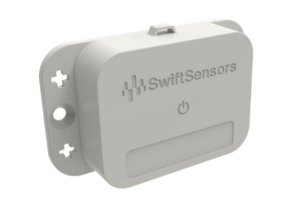Wireless vibration sensors are small devices that measure the vibrational activity of a machine or structure and wirelessly transmit the data to a monitoring system. These sensors use accelerometers to measure the movement and intensity of vibrations, and they can be attached to machinery, equipment, or structures to monitor their health and performance.
The wireless aspect of these sensors allows for real-time monitoring of vibrational activity without the need for hardwired connections, making them convenient and easy to install and maintain.
Uses of Wireless Vibration Sensors
Wireless vibration sensors are commonly used in the manufacturing and industrial sectors for a variety of purposes such as:
- Machine Monitoring. Wireless sensors can be used to monitor the performance and health of machinery and equipment in real-time. This information can be used to detect and prevent equipment failure, optimize performance, and improve maintenance schedules.
- Quality Control. Wireless sensors can be used to monitor key production parameters, such as temperature, pressure, and humidity, to ensure that products are being produced within specified quality limits.
- Inventory Tracking. Wireless sensors can be used to track the location and movement of raw materials, work-in-progress, and finished goods within the manufacturing facility. This information can be used to optimize inventory management, reduce waste, and improve efficiency.
- Energy Management. Wireless sensors can be used to monitor and control energy usage within a manufacturing facility. This information can be used to reduce energy costs, improve sustainability, and meet regulatory requirements.
- Predictive Maintenance. Wireless sensors can be used to collect data on machinery and equipment performance over time. This information can be analyzed using predictive maintenance algorithms to identify potential issues before they cause equipment failure, reducing downtime and improving maintenance schedules.
Types of Wireless Vibration Sensors
There are several common types of wireless vibration sensors. The specific type of sensor that is used depends on the needs and requirements of your organization, and the type of machinery, equipment, or structure that you want to monitor.
- Accelerometer-based sensors. These are the most common type of wireless vibration sensors and use accelerometers to measure the movement and intensity of vibrations. They can be used for a variety of applications, including monitoring the health of machinery and equipment, and monitoring the stability of structures such as bridges and buildings.
- Wireless structural health monitoring systems. These systems use a combination of wireless sensors, such as accelerometers and strain gauges, to monitor the health of structures, such as bridges and buildings, in real-time. They can provide early warning of potential safety issues, allowing maintenance personnel to take action before a breakdown occurs.
- Wireless condition monitoring systems. These systems use a combination of wireless sensors, such as accelerometers and temperature sensors, to monitor the health and performance of machinery and equipment in real-time. They can be used to detect issues with machinery and equipment early on, reducing downtime and improving maintenance schedules.
- Wireless impact sensors. These sensors use accelerometers to measure the intensity and duration of impacts, such as those caused by dropped objects or collisions. They can be used to monitor the safety of machinery and equipment in hazardous environments, such as in the oil and gas industry.
- Wireless strain sensors. These sensors use strain gauges to measure the strain and stress on a machine or structure. They can be used to monitor the health of bridges, buildings, and other structures, and to detect issues with machinery and equipment before a breakdown occurs.

How do Wireless Vibration Sensors Work?
Wireless vibration sensors typically work by measuring the vibrational activity of a machine or structure and wirelessly transmitting the data to a monitoring system. Here is a basic overview of the steps involved in the working of wireless vibration sensors:
- Measurement. The wireless vibration sensor contains an accelerometer, which measures the movement and intensity of vibrations in a machine or structure. The accelerometer converts the mechanical energy of the vibrations into an electrical signal that is proportional to the acceleration of the movement.
- Data Processing. The electrical signal is processed by the sensor’s onboard electronics, which converts the signal into digital data that can be transmitted wirelessly.
- Wireless transmission. The digital data is transmitted wirelessly to a monitoring system, such as a computer or smartphone, using a wireless communication protocol, such as Wi-Fi, Bluetooth, or Zigbee.
- Data analysis. The data received from the wireless vibration sensors is analyzed by the monitoring system to identify patterns and trends in the vibrational activity of the machine or structure. This data can be used to detect issues with the machinery and equipment, or to monitor the health and performance of structures, such as bridges and buildings.
- Alarming. If the monitoring system identifies an issue with the machinery or structure, it can trigger an alarm to alert maintenance personnel, allowing them to take action to resolve the issue.
The specific design and capabilities of wireless vibration sensors can vary, depending on the manufacturer and the exact needs of your business.
What are the Benefits of Wireless Vibration Sensors?
There are several benefits to using wireless vibration sensors that can impact your manufacturing or industrial company in a positive way. Here are just a few of the ways that wireless vibration sensors can be of help to your company.
- Real-time monitoring. Wireless vibration sensors provide real-time monitoring of machinery and equipment, allowing organizations to quickly identify and address issues before they cause downtime or equipment failure.
- Convenient and easy to install. Because they use wireless communication, wireless vibration sensors are convenient and easy to install without the need for hardwired connections. This makes them ideal for retrofitting existing machinery and equipment, or for monitoring equipment in remote locations.
- Improved predictive maintenance. By monitoring the health and performance of machinery and equipment over time, wireless vibration sensors can provide valuable data for predictive maintenance algorithms. This allows organizations to schedule proactive maintenance before a breakdown occurs, reducing downtime and improving maintenance schedules.
- Reduced downtime. By detecting issues with machinery and equipment early on, wireless vibration sensors can help reduce downtime caused by equipment failure, increasing productivity and profitability.
- Increased safety. By monitoring the health and stability of structures, such as bridges and buildings, wireless vibration sensors can help identify potential safety concerns and ensure that they are functioning within safe limits.
- Lower costs. By reducing downtime and improving maintenance schedules, wireless vibration sensors can lower maintenance costs and improve the overall efficiency of manufacturing and industrial operations.
Overall, the use of wireless vibration sensors can provide your business with valuable data and insights into the performance and health of machinery and equipment, helping to improve maintenance schedules, reduce downtime, and minimize the risk of equipment failure.
To learn more about wireless sensors from Swift Sensors, please contact one of our experts to begin the conversation.

